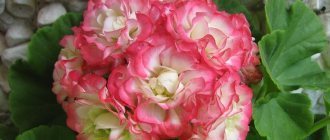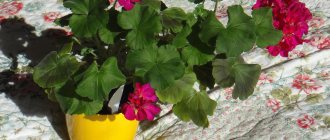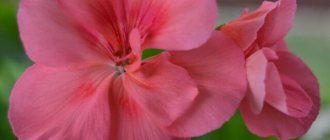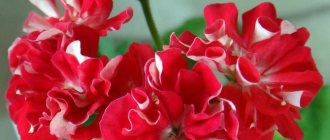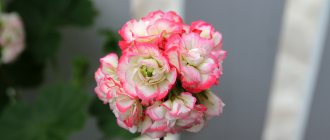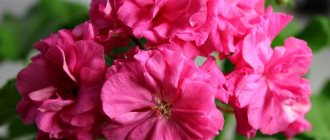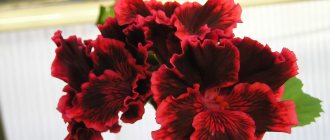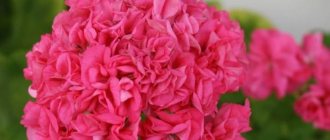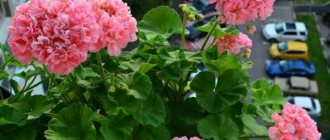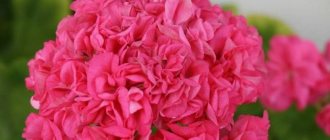Reproduction methods
Propagation can occur by using seed material or using cuttings. In the first case, the new shoots will not inherit the parental qualities, but this will not create obstacles to growing healthy plants.
Seeds - seedlings and their preparation
First, the seeds are placed in miniature greenhouses, first moistened in a growth stimulator. They need to be well ventilated, illuminated and moistened. The seeds are placed at a distance of 5 cm from each other.
Propagation by cuttings
To obtain new plants, you can use seeds or cuttings. In the first case, new plants may not inherit their parental properties.
When using cuttings, there is a risk that they will not be able to take root and will rot. However, if everything is done in compliance with the appropriate rules, then the process of propagation of these plants will occur without any problems.
To prepare cuttings, cut a branch from the mother plant that has not yet become completely woody. It is necessary that 3-5 internodes can be distinguished on it. If the cutting is too grassy, this will lead to its rotting.
The soil for planting is light and loose. It is recommended to use a mixture of soil and peat for this purpose. Before planting them in the ground, they need to dry for an hour.
When planting in the ground, you need to bury it in the ground so that one internode is closed.
Watering during the first day should be insignificant. If you germinate cuttings in transparent glasses, this makes it possible to observe how their roots grow.
Landing in the ground
If at least 5 leaves appear, the plants are transplanted into pots. After their length reaches 20 cm, they are pinched.
Product characteristics
| Package weight, kg | 0,5 |
| Packed height, cm | up to 20 cm |
| Pot diameter | 9 |
| Set | pot, soil, plant |
| Completeness | Pot, soil, plant |
| Purpose | for home/interior |
| Peculiarities | Beware of over-drying and too intense watering. |
| Features of care | watering, fertilizing |
| By smell | fragrant |
| Tray for collecting crumbs | without pallet |
| Style | Home interior, office, balcony, terrace, winter garden. |
| Manufacturer country | Russia |
| Type | indoor plant |
| Power type | It needs regular complex feeding through the foliage - by spraying and under the root - by watering. |
| Flowering type | copious |
Features of spathiphyllum
Rosebud pelargonium swanland pink
The genus Spathiphyllum includes perennial plants that are stemless. Their leaf blades grow from the very root and can be oval or lanceolate. In spring, flowering begins, an inflorescence appears on the bush, which is a spadix covered with a blanket. When the bush fades, trim the flower stalk as low as possible.
This plant is very popular among gardeners because, when cultivated indoors, it is easy to care for. It also has decorative leaf plates, which also contributed to its high popularity. Although this flower is considered unpretentious, in order for it to grow and develop normally, it must be watered abundantly, and also maintain high humidity in the room.
Botanical description
Alternanthera philoxeroides
- South American species, invasive in Florida (USA), Southeast Asia, Australia
Annual and perennial plants, sometimes small shrubs. The stems range from creeping and recumbent to erect, and in some species they float in the water column. Leaves are opposite, petiolate or sessile, entire, lanceolate to ovate.
Inflorescences are apical or axillary, cylindrical, spicate or capitate, with membranous bracts. The flowers are bisexual, with 5 membranous tepals, often unequal. Stamens number 3-5, fused at the base into a short tube.
The fruits are sacs with doubly convex or ovoid-oblong seeds.
The elasticity of wood during various manipulations with it.
The static bending of alder wood is 80 MPa
Tension across the fibers 7 MPa
Tension along the fibers 95 MPa
Not only alder wood is used by people in the process of their life.
Alder bark is used to make dye that is used to color leather and cloth. The bark is used to produce dye, mainly of the black alder variety.
An infusion of alder fruits will help stop nosebleeds. Because alder fruits have hemostatic agents.
In addition, such decoctions have a beneficial effect on the functioning of the gastrointestinal tract. Thus, a decoction of the bark will help with digestive disorders and normalize the microflora of the stomach.
Also, alder leaves and fruits contain antihistamine microelements. Therefore, they help reduce and calm allergic manifestations.
Alder seeds and leaves have an antimicrobial effect. They are also used as a diaphoretic, for example, for colds.
It is useful to make foot baths from a decoction of alder leaves. The decoction will help in the fight against skin dermatitis. It can also relieve stress.
In the fight against childhood diathesis, an infusion of alder flowers, which must be collected at the very beginning of flowering, has proven its effectiveness.
Features of care
When caring for rosebud pelargonium, it is important to follow the necessary rules. If they are violated, the plant will grow sluggish and non-viable.
Watering, lighting, fertilizing, humidity
When caring, it is not advisable to water the plant abundantly. It does not like bright sunlight. Intense light depresses pelargonium - it becomes lethargic and faded, and blooms worse. Outdoors, resistance to sunlight is higher.
It is necessary to water moderately. Typically, water at room temperature is used for this. Complete drying of the soil is undesirable, but it is also not recommended to contribute to the formation of excess moisture. If there is excess moisture, the roots may begin to rot.
The need for watering can be determined by testing the soil with your finger. If it does not crumble, but remains on the skin, then there is no need to water it yet.
Then you need to prune. In this case, it is necessary to remove branches that are too weak and those that have become too long. In this case, you need to leave only the first 10-15 centimeters of the stem.
If you follow these rules, within a month after planting in the ground, the pelargonium will be well leafed and ready to bloom.
Spring work
In spring, the growth rate of pelargonium increases. It is recommended to replant the flowers into new soil at this time.
At first, it is important to carefully ensure that watering is not too intense. When a new shoot begins to develop on the stem, we can confidently say that the flower has taken root in the new place
Summer work
When caring, you need to take into account that pelargonium does not like when its leaves are covered with dust. To prevent this from happening, they must be wiped.
Winter care
At this time, the plant crumbles and flowering does not occur. It is recommended to keep it dormant. To do this you need to provide:
- A temperature that does not exceed 15 degrees Celsius.
- Rare watering.
- No fertilizers.
In this condition, the plant will be able to successfully overwinter.
Care during the flowering period
The plant needs to be fed at this time. To do this, before and during flowering you need to use phosphorus and potassium fertilizers.
Preparing for winter
This plant will not be able to withstand winter frosts when outdoors. In winter, it should be kept at home.
Care problems
Geranium is vulnerable to cold temperatures. It is not recommended that she stay for a long time in conditions where the temperature is less than 10 degrees Celsius.
If the flower is watered too intensely, this can lead to rotting of the roots.
Caring for a plant at home or in a greenhouse
Growing a flower at home or in a greenhouse requires effort. But pelargonium repays generously by helping to stabilize the psychological climate in the family, and simply pleasing to the eye. Plant care is of a special nature, which includes several important rules:
- Do not overdo it with watering to prevent root rot;
- Direct sunlight should be avoided unless the flower grows outdoors;
- The soil of the flower should not be allowed to dry out;
- Water for irrigation should be at room temperature.
Swanland Pink and Apple Blossom Rosebud my observations
I have already talked a little about my beautiful pelargoniums and I would like to dwell in more detail on the characteristics of rosebuds. I only have three: Swanland Pink, Apple Blossom Rosebud and ringless. I’ll tell you about my observations on caring for them; these are not truisms, but a personal opinion. Rosebud pelargoniums got their name from the shape of the flower, it is like a rose. In other words, this is terry pelargonium.
All pelargoniums feel better at low temperatures: 10-20 degrees. In rosebuds, high temperatures cause the rosette to open incompletely. In the autumn, on the pelargonium loggia they produced the largest possible flowers, almost turning them inside out)))
Swanland Pink
Rosebud pelargonium with pink flowers. The color is pure pink. It blooms readily, produces a lot of flower stalks, on one Swanland Pink root (everyone lives in a small pot, there is not enough space) all summer there were 4-5-6 flower stalks, from the main and side shoots. Doesn't crumble.
Apple Blossom Rosebud
Translated as “apple tree bouquet.” The flowers are white with a pink border.
In summer, in the sun, the border is intensely pink. In autumn, pale pink, almost invisible (little sun).
The size of the flower is the same; in cold temperatures it becomes larger. It doesn’t fall off, when the peduncle dries out completely, I break it off. I have it growing in a small pot, but it’s on the south side. Therefore, it bloomed well in the summer (they write about it that the “horse” does not bloom until it gains mass). The first flower appeared on the very baby.
I spend the winter on an insulated loggia, it’s cool there. In the spring, I cut all pelargoniums into fresh ones, because... they “eat up the earth”, the earth after them is empty, like dust.
Rosebud pelargonium does not reproduce by seeds, so you should not look for where to buy seeds.
Thanks for stopping by! By
Growing problems, diseases and pests
Geraniums may look unhealthy for several main reasons, which are listed below. To protect the flower, they resort to regular inspection:
Yellowing of the leaves indicates excessive dryness of the air in the room and lack of lighting. You can cope with the problem by moving the pots with geraniums to a suitable place. Lethargy of leaves and stems means an excess of moisture at the roots of the plant
In such a situation, it is important to adjust watering. Rose flowers dry and wither when the plant is infected with a fungal infection. Treating the bush twice with Fitosporin at weekly intervals may help. When a bacterial disease occurs, geranium leaves become covered with brown spots.
The solution is urgent transplantation into disinfected soil, treatment with fungicides and regulation of the watering regime. Although the plant repels most insect pests, it can be destroyed by aphids or whiteflies. Get rid of them using appropriate insecticides.
Rosebud geranium blooms very luxuriantly
With proper care, the gardener will not have to face problems when growing pelargonium.
The beauty of rosebud geranium flowers, which look like miniature, almost toy roses, is unique. The appearance of the lush inflorescences of pink pelargonium justifies and covers all the efforts that were made to grow the plant in a home or apartment.
Care and cultivation
In order for flowers to actively develop and not fade, you need to provide them with care. Most varieties are unpretentious to keep, so growing them will not present any particular difficulties.
Content temperature
The most suitable temperature for plants varies between 25-27 degrees. If there is a significant deviation from these indicators, growth slows down.
Lighting
Pelargonium is considered a light-loving plant. Lack of lighting leads to the production of essential oils and a decrease in flower size.
Humidity
Air humidity for growing plants should be within normal limits. Pelargonium easily tolerates minor drought or excess humidity. In the warm season, it is recommended to place the flower on the balcony or terrace for fresh air.
Watering
The plant needs moderate watering. The soil in the pots should be moistened as it dries, avoiding excessive addition of water to avoid rotting of the roots.
The soil
The best option is fertile, light soil with good drainage. If you prepare the soil mixture yourself, you should add peat and sand to the soil.
Pot
When choosing the size of the pot, you need to take into account the variety being grown. Depending on the size of the plant, a container with the appropriate dimensions is required.
Feeding and fertilizer
Any variety of pelargonium reacts negatively to organic fertilizers, so it is better to focus on complex mineral fertilizers containing phosphorus, nitrogen and potassium. Do not use a solution that is too concentrated, as this may disrupt the development process.
Anti-aging transplant
As the flowers grow, it becomes necessary to transfer them to larger pots. Planting also helps rejuvenate the plant by renewing the soil.
Pruning and crown formation
Old and yellowed leaves on the plant continue to absorb nutrients, so pruning is required.
How to care in winter
Care with the onset of winter does not differ from the basic one. The only thing that needs to be done to protect the plants is to remove them from uninsulated places.
Pest protection
To combat parasites, it is enough to spray with insecticidal preparations. Large harmful insects can be removed manually.
Cuttings
Propagation by this method involves cutting healthy cuttings from plants. Excess foliage is removed from them, leaving only the top pair, and then they are left to dry. Dried cuttings are buried in small containers and provided with standard care.
Seeds
After collecting seeds from growing pelargonium, you can sow them in new pots. After planting, the soil with the seeds is watered and fertilized for active germination.
Dividing the bush
To propagate by division, a bush is dug out of the ground and divided into several equal parts. Then each part is planted in separate containers.
With the onset of winter, it is worth putting the pots in a warm place. When exposed to cold, the foliage and flowers darken and then begin to wilt.
Pelargonium Ingrid - characteristics and cultivation
Pelargonium Queen Ingrid is a beautiful plant, a representative of the zonal rosebud pelargoniums with pink flowering. The unpretentiousness and decorative nature of the variety are the main reasons for its popularity. Long flowering and large flowers are pleasant bonuses for the gardener.
Similarities and differences between the two varieties
Representatives of the aristocracy among geraniums, Ingrid Grycksbo pelargonium and Ingrid pelargonium, look similar to each other, but have some varietal differences.
Pelargonium Queen Ingrid is the real pride of any gardener
Both are classified as dwarf zonal and are highly decorative. However, Ingrid Grixbo's pelargonium flowers have a richer orange hue. In the middle there is a snow-white core. The leaves are unevenly colored: the central part is light green, the edges are rich in color. The bush itself is neat and does not need shaping.
Description of pelargonium Queen Ingrid:
- Large double flowers. The petals are soft pink, often decorated with green or white spots, but can also be monochrome.
- The leaves are rich green, the shade is uniform over the entire surface.
- The root system is branched.
The flowering period is from early March to the second half of October.
Note! For long-lasting elegant flowering, it is important to keep the bush in the cold during the winter months (December and January)
Planting and care
The variety is unpretentious, ideal for beginners
However, it is important to follow certain care recommendations
Selecting a location, substrate and container
A bright place is suitable for Ingrid pelargonium, so the pot with the flower is placed on a south-facing windowsill. In summer, when the rays of the sun are especially scorching, light partial shade is created for the plant by curtaining the window with tulle. However, this is done for any geranium or pelargonium.
The soft pink flowers of Ingrid pelargonium look very romantic
It is important to protect the plant from drafts, but it needs fresh air, so the room where it grows is regularly ventilated. Suitable soil - neutral or slightly acidic
It is permissible to purchase a ready-made composition for geraniums in the store or mix it yourself using garden soil, coarse river sand and turf in equal quantities. It is necessary to make a drainage layer in the pot; this is the best prevention of waterlogging of the soil, which is dangerous for the plant.
Suitable soil is neutral or slightly acidic. It is permissible to purchase a ready-made composition for geraniums in the store or mix it yourself using garden soil, coarse river sand and turf in equal quantities. It is necessary to make a drainage layer in the pot; this is the best prevention of waterlogging of the soil, which is dangerous for the plant.
Note! If the gardener only has a rectangular box, then it can also be used by planting two or three plants
Feeding and pruning
Pelargonium rosebud Queen Ingrid or Grixbo needs to be fertilized with geranium compounds in the spring, at the beginning of the growing season, as well as during budding and flowering. It is unacceptable to use organic matter for feeding.
Note! To form a bush, pinching the top is carried out; this stimulates the growth of side shoots and helps to avoid the flower being stretched in height.
Diseases and pests
Yellowed pelargonium leaves indicate that the plant does not have enough light. If they begin to wither and fall off, then this is a sure sign of waterlogging in the soil; the plant must be promptly replanted.
Note! The main pests of the variety are aphids and whiteflies; complex insecticides are used to get rid of them. https://www.youtube.com/embed/0FJmnAOx4TE
Such is the amazing pelargonium, Queen Ingrid, whose soft pink double flowers really evoke associations with something regal and aristocratic. And the Grixbo variety, with its brightly colored petals, can compete with almost any domestic flower.
Queen ingrid pelargonium
Pelargonium rosebud Queen Ingrid is an early, long-flowering variety. The flowers are arranged in several rows and during flowering resemble a bouquet of unblown roses.
Description Pelargonium rosebud Queen Ingrid. Compact variety, characterized by early and long flowering. The leaves are a uniform green color. For abundant flowering, it requires cold maintenance for 4-6 weeks (December-January).
Popular varieties
Sutarves igor pelargonium
Gardeners value this flower for its unpretentiousness and attractive appearance. However, the plant has a huge number of varieties, differing both in buds and in the subtleties of care. Let's look at the most popular varieties of Himalayan geranium.
The Baby blue variety is a low bush, reaching approximately 30 centimeters in height. According to the name, it has blue-violet rather large flowers. The veins are not too pronounced.
The Gravetye variety is distinguished by its bright flowers. They measure up to 5 centimeters and are purple with a blue tint. The veins in this case are obvious, burgundy-red. The core of the flowers is white, smoothly turning into a purple hue, and from there into its main color.
Irish Blue. This variety is also represented by small bushes with large bright flowers. The buds are purple, with a slight touch of blue; as they approach the center, the color becomes reddish. Most often, this plant is used to improve the territory; it is planted along the perimeter of paths and around flower beds.
The “Plenum” variety is considered the most famous; it is often chosen by summer residents for planting on their plots. The main highlight is the double flowers of lilac color with possible shades of blue, purple and pink. The dimensions of the bush are standard, about 30 centimeters in height and approximately the same in width.
"Summer sour." This variety has pronounced frost resistance and feels great in summer cottages in various regions of our country. It has double violet-lilac flowers of decent size, which are scattered in large quantities throughout the bush. Flowering begins in June and ends with the beginning of autumn.
The "Derrick Cook" variety has very beautiful and large flowers. They have a round shape and are located on thin stems. The color is white, the veins are lilac-violet. When the plant fades, the buds appear a soft blue tint and the leaves turn deep red. The bushes are quite voluminous, up to 60 centimeters wide, and tolerate drought and difficult weather conditions well.
The Kaya variety is quite rare, but at the same time worthy of attention. It is very unpretentious and does not require painstaking care; it has large light lilac-blue flowers with pronounced veins and a delicate aroma. Bush size is average
The plant tolerates frost well and is resistant to the development of various diseases. Despite the fact that this variety of geranium loves light, it will also do well when placed in partial shade.
The size of the bush is average. The plant tolerates frost well and is resistant to the development of various diseases. Despite the fact that this variety of geranium loves light, it will do well when placed in partial shade.
About the Himalayan geranium variety Baby blue, see the video below.
Pelargonium rosebud Mary in a pot d-7 cm rooted cuttings
Pelargonium - this indoor plant is a perennial subshrub with strong herbaceous and rather fleshy shoots. Depending on the variety, erect and creeping varieties may be found. Growing pelargonium is not difficult. By following simple rules and creating favorable conditions, you will achieve lush and bright flowering. Temperature Comfortable temperature for pelargonium is 20-25 degrees. If the plant is on a balcony or terrace, it is better to protect it from gusts of wind and drafts. From October to the end of February, you can organize a cool winter for the plant with a temperature of 12 to 15°C. In such conditions it is at rest and does not grow.
Humidity The only type of pelargonium that does not tolerate dry air is royal pelargonium. An air humidifier must be installed next to it. Other species are calm even to winter dryness due to heating radiators. For normal development, geranium requires fresh air, which makes it very hardy. Therefore, in summer it is recommended to keep it more in the fresh air or, at least, grow it on the balcony.
Light Pelargonium is a light-loving plant that can tolerate direct sun. With a lack of light, the leaves begin to turn yellow, the lower leaves die and expose the stem. Flowering weakens or may stop altogether. To feel good, she needs 12 hours of daylight, so south and southwest windows are what she needs. To ensure that the bush grows evenly and all its sides receive a lot of light, periodically rotate the pot on the window.
Watering Pelargonium is considered a drought-resistant plant. It is recommended to water the flower only when the top layer of soil in the pot dries out. However, the earthen clod should not be allowed to dry out too much. In winter, geraniums (pelargoniums) can be watered no more than twice a week and given maximum light.
Soil Pelargonium loves light neutral soils. Peat, sand, perlite, and vermiculite will help lighten the soil.
Top dressing Pelargonium is a fast-growing flower. And during the growing season from March to August, it needs regular feeding. Organic fertilizers should never be used to feed the plant. It is best to saturate the soil with mixtures of potassium, phosphorus and nitrogen in equal proportions.
Transplantation rules It is best to replant geraniums in the spring. To reduce the risk of injury to the root system, you need to moisten the earthen ball 2 hours before transplanting. It is necessary to put drainage at the bottom of the pot. Also important is the choice of pot in which the plant will live. You should not buy a very large pot, because the plant does not need a lot of soil for normal development. If the container is too large for the flower, then over time the soil will become waterlogged, which will lead to rotting of the root system. Many gardeners prefer to use containers made of clay and ceramics because this material perfectly removes remaining moisture and salts, as a result the plant grows and develops well.
Planting an overseas beauty
Only by planting pelargonium correctly can you expect that it will delight its owners with luxurious flowers.
Choosing a site for planting and preparing the soil
This plant can be grown in a room, but also on a balcony or planted in a garden. When planting, it is recommended to use not pure soil, but mixed with peat or other substance, which will make the soil more loose.
Landing dates
Transplantation into the ground is carried out in the spring. Before doing this, the soil must be fertilized. To do this, you can use a self-prepared mixture, which will include:
- peat;
- turf land;
- perlite;
- coarse sand;
- humus.
To leave the mixture, you will need to prepare the starting substances in the ratio 2:4:1:1:2 and mix them thoroughly. You can instead use store-bought soil that is neutrally acidic (pH 5.5-6.5).
Queen ingrid pelargonium
Pelargonium rosebud Queen Ingrid is an early, long-flowering variety. The flowers are arranged in several rows and during flowering resemble a bouquet of unblown roses.
Description Pelargonium rosebud Queen Ingrid. Compact variety, characterized by early and long flowering. The leaves are a uniform green color. For abundant flowering, it requires cold maintenance for 4-6 weeks (December-January).
Among the large species diversity of unpretentious pelargoniums, Pelargonium rosebud deserves special attention. A true aristocrat, it is distinguished by beautiful large foliage of various shapes depending on the variety, lush inflorescences consisting of large (up to 5 cm) flowers. In shape they resemble rose flowers, single or double. The petals can be painted in a wide variety of colors: from white to dark red, through all the variety of pinks, reds and purples; they can be plain or with spots, streaks, corrugated, fringed or torn. Flowering is very abundant and colorful, lasting from May-June to August-September. The shoots of rosebud pelargonium become lignified at the base. Like other varieties, pelargonium leaves are hairy and have a characteristic aroma, but many varieties have odorless leaves.
Location Pelargonium rosebud Queen Ingrid. The optimal location for rosebud pelargonium is an eastern window with diffused sunlight, but without a heating radiator under the window sill. This species is not suitable for planting in the garden in the summer, as it is afraid of rain and wind, but feels good on closed verandas, terraces and loggias. When the first frost occurs, the plant must be moved to a warm place.
Temperature regime for Pelargonium rosebud Queen Ingrid. Pelargonium rosebud does not tolerate extreme heat: at temperatures significantly above +25 ° C, it stops growing and does not bloom. In winter, the optimal temperature is within +15. +20 °C.
Planting Royal Pelargonium rosebud Queen Ingrid. The best container for planting rosebud pelargonium will be a ceramic pot with perforations to drain excess moisture. Be sure to provide drainage, and use a mixture of turf soil with a high organic content as a substrate. Within two weeks after planting, provide the plants with shade and timely watering.
Care of Pelargonium rosebud Queen Ingrid. The main conditions for the successful cultivation of rosebud pelargonium are compliance with the correct temperature conditions, additional lighting and moderate watering. Regular pinching of the tops of the shoots ensures better tillering of the bush, but it must be stopped long before flowering to allow buds to form. Young plants bloom more abundantly than adults, so annual propagation of pelargonium is recommended. During the period of active growth, feed plants with low doses of fertilizers with a high content of potassium and microelements. During the period from March to August, provide the plants with regular watering, but do not allow stagnation of moisture. Remove fading inflorescences promptly.
Reproduction of Pelargonium rosebud Queen Ingrid. To propagate Pelargonium rosebud, cuttings from apical shoots are used. The best time for reproduction is late summer-early autumn. Before planting in the substrate, sprinkle the cuttings with crushed coal with the addition of “root” and dry for a couple of hours. Rooting in water is not suitable for cuttings of royal pelargonium: with this method they will inevitably rot. After rooting, the cuttings are transplanted into pots with a light nutrient substrate and drainage at the bottom.
Use of Pelargonium rosebud Queen Ingrid. Pelargonium rosebud is more of an indoor plant; it is successfully grown in greenhouses and winter gardens, and during the warm season it decorates closed terraces, verandas and loggias.
GOODS TO DISTANT REGIONS ARE DELIVERED ONLY BY EMS DELIVERY. FAR REGIONS INCLUDE: Republic of Tyva, Republic of Buryatia, Republic of Sakha (Yakutia), Primorsky Territory, Khabarovsk Territory, Amur Region, Altai Territory, Kamchatka Territory, Sakhalin Region, Transbaikal Territory, Jewish Autonomous Region, Chukotka Autonomous Okrug. Irkutsk region, Magadan region, Yamalo-Nenets Autonomous Okrug, Altai Republic, Krasnoyarsk Territory
Features and characteristics of rosebud geraniums by species groups
There are more than two hundred and fifty species of pelargonium. There are both annual and perennial plants, which in turn are divided into bushy, semi-bush and herbaceous varieties. Both zonal and ivy-leaved pelargonium are suitable for growing indoors. A bush plant can grow up to 50 cm, and a hanging plant can grow up to one meter. Perennial pelargoniums need to be changed every 4–5 years, otherwise they will lose their decorative appearance. Thanks to the beneficial properties of the plant grown indoors, pathogenic bacteria are eliminated.
Zonal pelargoniums: popular varieties
In terms of hardiness and strength, zonal rosebuds are the leaders; they grow tall and vegetate quickly if they are not formed. They are considered perennial; the leaves of the plant are distinguished by light and dark zones. There are standard, dwarf and miniature sizes of bushes. The flowers are ordinary, double and rosebud. The most popular varieties include:
- Rumba Fire. It is noticeable for its bright red color and many flowers belonging to non-double varieties.
- Bravo Pastel. It has white edges of petals and a pink center, also classified as a non-double variety.
- Royal Salmon stands out for its large flower with a dark center, the edges of the petals are wavy.
- The pink terry variety has petals arranged in several rows at once.
- Angelic pink, which is reminiscent of Pansy.
- Red rosebud pelargonium is popular; its flowers resemble beautiful rosebuds.
Pelargonium Rosebud Red is one of the royal perennials; it attracts with its large double flower of juicy scarlet color. One of the brightest representatives of zonal plants is Pelargonium rosebud Queen Ingrid, characterized by medium growth energy. Terry petals of this species, such as pelargonium rosebud Margaretha, are quite densely located to each other, which gives the feeling that the flower will never bloom.
Ivy-leaved or ampelous pelargonium
The ampelous variety is characterized by the presence of glossy leaves, quite durable, which fall in a cascade; they are also compared to ivy. Plant types include double, semi-double and non-double varieties. The most popular of them are:
- Redpandora, which has bright coral-red petals reminiscent of tulip petals, blooms all year round. Pelargonium rosebud Red Pandora is increasingly found in winter gardens, enclosed terraces, and greenhouses.
- Pygmy salmon, whose leaves are most similar to ivy, is a relatively new variety, semi-double.
Pelargonium Emma has similar features to tulip petals; it stands out among others with its pale pink, delicate color. Its peculiarity is that as the flower ages, the leaves straighten out and it blooms profusely with bouquet inflorescences.
The variety of colors of pelargonium petals will not leave anyone indifferent:
- Viva-Carolina has fondant purple flowers.
- Bornholn – rich reds.
- Plum Rambler is a blend of plum and burgundy.
- Swanland Pink / Australien Pink Rosebud is a soft pink shade.
- Orange Bud resembles a burning sun.
- Blue Sybil pleases with lilac-blue petals.
- Appleblossom Rosebud is special for its iridescence.
Some varieties of rosebud pelargoniums are characterized by the presence of a white base, among them Anita and Rosebud Supreme, which creates an accentuated shade of the rich color of the center. An excellent property of rosebud geranium is the ability to change color, depending on the conditions of detention. April Snow is considered a kind of chameleon due to its ability to change its milky-porcelain hue to crimson if placed under the sun's rays. One of the old-timers of pelargoniums is Red Rambler, a fairly popular species; no less popular are the new varieties - Pelargonium rosebud Prins Nikolai, Westdale Appleblossom and Anita.
Choosing the right bulb
Hazel grouse corms are different from other bulbous bulbs; they have some features that should be taken into account when purchasing planting material:
- Large size. A good onion weighs at least 500 grams. Some specimens reach a size of up to 1 kg.
- Thick consistency. Healthy planting material is quite hard to the touch, without visible soft areas, rot or damage.
- A through hole in the bulb. The dried residue of last year's stem, which is located in the center of the hole, does not need to be removed.
In addition, it is worth paying attention to the presence of sprouted roots, which is acceptable. https://www.youtube.com/embed/jnr4PfECI4o
Description of rosebud pelargoniums Ingrid Grixbo and Quinn Ingrid, caring for them at home
Pelargonium Ingrid received such an unusual name for a reason. Translated from Old Norse, Ingrid means beautiful, wonderful. Indeed, such gorgeous flowering on a compact bush fully corresponds to this characteristic.
Differences and similarities of pelargoniums Ingrid Grixbo and Queen Ingrid, their description
Two sisters Ingrid Grixbo and Quinn are the most beautiful hybrids. There are both similarities and differences in their appearance:
- Both bushes are zonal and compact. And Ingrid Grixbo's pelargonium is also dwarf.
- Pelargonium leaves are the same in shape, but different in color. Pelargonium Queen Ingrid has leaf blades of a uniform green color, while Grixbo has a concentric zone on the leaf with a light green center.
- The shape of the petals, flowers and the caps of the inflorescences themselves is the same for both varieties.
Royal Ingrid
- The color of the inflorescences is the main difference. Pelargonium Queen Ingrid is a soft marshmallow color that is a shade darker in the center than at the edges of the petal. Pelargonium Ingrid Grycksbo has a light stalk and petal center with a smooth transition to bright red-orange edges.
- The red beauty blooms while still “baby”, and the soft pink beauty – later. For abundant flowering of rosebud pelargonium Queen Ingrid, the main maintenance condition is a properly organized dormant period.
Green pattern of Grixbo leaves
The conditions for keeping and caring for the Ingrid variety are practically no different from the conditions for ordinary pelargonium.
Planting and further care of Ingrid pelargonium at home
Hybrid varieties of pelargonium have retained their previous care requirements - a lot of light, moderate watering and low temperature.
Choosing a place, soil and pot
Pelargonium Knight Salmon - description of varieties of the Salmon series
For the beautiful Ingrid, an eastern window and diffused light are optimal. In winter, it is necessary to add additional light to the greenery so that the bush does not stretch out. The pot should be placed away from heating devices: dry air and high temperatures will not benefit the decorative properties of terry geraniums.
A clay pot is suitable to absorb excess moisture or a ceramic pot with perforations to drain excess moisture. The size of the pot should match the size of the root system.
It is important to know! Well-organized drainage is the key to healthy pelargonium. The soil can be taken ready-made
If you mix it yourself, then turf soil with peat, sand and humus are taken in equal parts
The soil can be taken ready-made. If you mix it yourself, then turf soil with peat, sand and humus are taken in equal parts.
Watering, spraying and humidity
Watering should be moderate. In summer - frequent, but not abundant. During the rest period it is reduced to a minimum. With the beginning of active awakening - as the top layer of the earth dries out.
You should not spray fuzzy leaves, as well as flower buds. Maintain humidity at a comfortable level for indoor plants, within 40%.
It is important to know! Pelargonium Ingrid cannot be taken out into the garden in the summer, it will not survive rain and gusts of wind, scorching sun and high temperatures
Feeding
Nutritious soil ensures the abundance and duration of flowering. With regular fertilization, geranium blooms with bright and large inflorescences. From the beginning of spring, the flower needs weekly feeding with the obligatory content of potassium and microelements.
Trimming
The bushes are already compact; they do not need pruning. But pinching will add density to the greenery and stimulate active growth. The main thing is not to pinch while setting the buds.
Compact bush Grixbo
Reproduction
Pelargonium Lake - variety characteristics and cultivation
Young bushes bloom more abundantly than adults, so experienced gardeners regularly update their Ingrid. The best method of propagation is cuttings from young shoots. Royal pelargonium takes root only in the soil. To successfully root geranium, you need a nutrient substrate and drainage.
Diseases and pests, means of combating them
Pelargonium Sutarve Clara San - variety characteristics and cultivation
Hybrids are disease resistant. But an incorrect watering regime can provoke fungal infections of the roots or stems. Timely detection and treatment contributes to a speedy recovery.
Among the pests that live on geraniums are aphids, whiteflies and mealybugs. Pelargonium needs to be treated for insects every spring.
Beautiful Ingrid requires attention and care, but will gladly thank you for this with the most beautiful hats of flowers.
Late flowering tulips: bloom from the second half of May
Simple late tulips, lily-flowered, fringed, green-flowered, Rembrandt tulips, parrot and double late tulips bloom late. The height of their peduncles ranges from 40 to 80 cm and above.
Simple late tulips (Single Late, SL)
They make up a fifth of the entire assortment due to their varied colors (there are also two-color varieties) and stability in cultivation. The flowers are characterized by a goblet-shaped flower and a square base.
Interesting varieties of tulips for planting in a private garden:
- white with yellow Angels Wish,
- dark burgundy Dom Pedro and Queen of Night,
- yellow-red Holland Queen,
- apricot yellow Long Lady,
- Sky High Scarlet.
in the photo there is a Queen of Night tulip
Fringed tulips (Fringed, Fr)
The edge of the petals of tulips from the class Fringed (Fr) is decorated with a needle-shaped fringe similar to frost. The first fringed tulip was registered in 1930.
Fringed tulip variety Fancy Frills
Fringed tulips also have the most varied colors:
- the pale pink Fancy Frills have almost white petals at the base,
- Exotic Sun and Crispy Gold varieties are bright yellow,
- Swan Wings – white,
- Aria Card – white and lilac,
- Dallas – pink.
variety of fringed tulip Exotic Sun
Other interesting varieties of fringed tulips:
- Valery Gergiev with a bright red flower,
- Green Jay is one of the greenest tulips in this group.
Green tulips (Viridiflora, V)
Green-flowered tulips (Viridiflora, V) have a green color on the back of the petals throughout the entire flowering period. The color of the edges of the petals can be white, pink, red, yellow.
The most famous representation of this class is the white and green Spring Green.
The Esperanto tulip is very popular, the color of the flower is bright pink with green feathers, leaves with a white edging.
green tulip variety Florosa
In addition, green-colored tulips of such varieties as:
- white-green Greenstar,
- red-white-green Flaming Springgreen,
- pink-green Virichic, Groenland, Lucy, Nightrider, Florosa,
- yellow-green Golden Artist, Yellow Spring Green, Marax Groen, Formosa,
- orange-green Green River.
green tulip variety Flaming Springgreen
Rembrandt tulips (Rembrandt, R)
The class Rembrandt tulips (Rembrandt, R) unites all tulips whose variegation is genetically fixed. The flowers are goblet-shaped and quite large. On the modern market, the class is represented by the smallest number of varieties and is practically never found on sale.
Lilyflowering tulips (L)
Lilyflowering tulips (Lilyflowering, L) have a unique flower structure with pointed petals that bend outward.
Interesting varieties of lily-flowered tulips:
- red Royal Gift,
- pink Madalyn,
- orange Ballerina Design,
- deep yellow Ballade Gold
- and yellow-red Ballade Dream.
tulip variety Ballade Dream
Parrot tulips (Parrot, P)
Parrot tulips (Parrot, P) have a distinctive appearance due to the rugged or wavy edge of the petals, reminiscent of disheveled bird wings. The peduncles are quite weak and bend under the weight of large flowers, up to 20 cm in diameter.
parrot tulip variety Orange Favorite
In addition to the famous Black Parrot tulip, the group includes other equally interesting varieties.
For example,
- orange Avignon Parrot, Orange Favorite, Professor Rontgen,
- apricot with pink and green shades Apricot Parrot,
- pale lilac Arabian Mystery Parrot,
- pink Proud Parrot, Weber's Parrot Pink,
- dark cherry, almost black with variegated leaves Frozen Night,
- white with crimson strokes Estella Rynveld,
- soft pink with green veins Green Wave
- and a very green Super Parrot.
tulip variety Estella Rynveld
Terry late tulips (Double Late, DL)
Very large flowers, similar to small peonies, in double late tulips (Double Late, DL). Even flower stalks often break off under their weight.
Interesting varieties of terry late tulips:
- greenish white Ice Age,
- pink Angelique,
- white-red Gerbrand Kieft,
- orange-red Golden Nizza,
- yellow-pink Dream Touch.
- The Color Burst variety has rich lavender petals and a yellow center.
late terry tulip variety Color Burst
The orange-red variety Gudoshnik Double has an unusual history: a densely double sport was obtained from the old variety Khudoshnik. Dutch manufacturers simply called it Gudoshnik Double.
